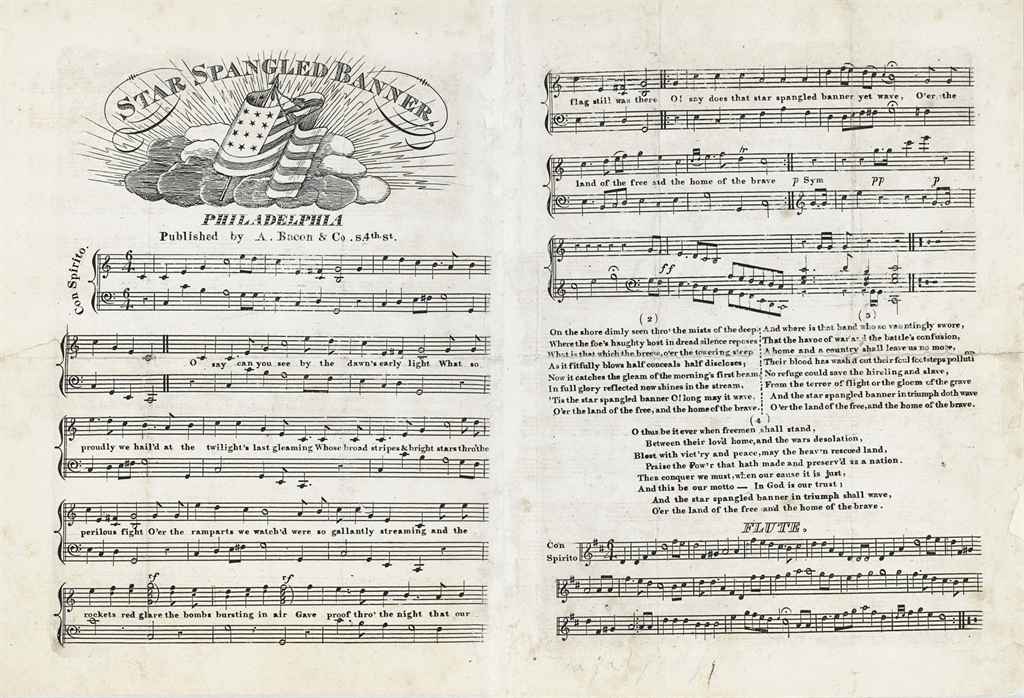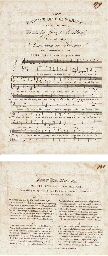STAR SPANGLED BANNER – [KEY, Francis Scott], "Defence of Fort M'Henry", excised from the Baltimore Patriot and Evening Advertiser , 20 September 1814. The earliest printing of "The Star Spangled Banner" in private hands and the song's first printing in a newspaper – published only days following its composition by Francis Scott Key. The text of Key’s verses appears under the title, "The Defence of Fort M'Henry" with details of its composition: "The annexed song was composed under the following circumstances – A gentleman had left Baltimore, in a flag of Truce for the purpose of getting released from a British fleet a friend of his, who had been captured at Marlborough. He went as far as the mouth of the Patuxent, and was not permitted to return lest the intended attack on Baltimore should be disclosed. He was therefore brought up the bay to the mouth of the Patapsco, where the flag vessel was kept under the guns of a frigate, and he was compelled to witness the bombardment of Fort McHenry, which the Admiral had boasted that he would carry in a few hours, and that the city must fall. He watched the flag at the Fort through the whole day with an anxiety that can be better felt than described, until the night prevented him from seeing it. In the night he watched the Bomb-Shells, at an early dawn his eye was again greeted by the proudly-waving flag of his country." The verses were to be sung with the melody of a popular British tune "Anacreon in Heaven". The chronology of the U.S. national anthem’s composition and earliest printings is well documented. It was written at a low point in the War of 1812, weeks after the British had captured Washington and burned the U.S. Capitol, turning next to attack Baltimore, a hotbed of American pro-war sentiment. Key, who had been a captive of the British fleet near the entrance to Baltimore Harbor since 7 September, spent the night of the 13th-14th observing the battle together with two other American detainees, including a government agent for prisoner exchange named John Stuart Skinner. In the immediate aftermath, jubilant at the British failure to subdue Fort McHenry and capture the city, Key began his rough draft of what would become “The Star Spangled Banner.” Over the next several days, the invaders abandoned their unsuccessful assault, withdrew their troops from the outskirts of the city, and prepared to set sail. Key and the other prisoners were released from captivity and returned to shore on the evening of 16 September and he finished composing the song in his room at a Baltimore inn the same night. Key’s composition struck an immediate chord among Baltimore’s battle-weary citizens and the song was hastily printed as a broadside handbill (this is believed to be what the Baltimore Patriot’ s editors referred to when they noted that this "beautiful and animating effusion" had "already been extensively circulated"). At some point on the morning of 17 September, J.S. Skinner called on Key at the inn and obtained a manuscript of the song. Then, as Skinner would later recount, he "passed it to the Baltimore Patriot, and through it to immortality." Brigham identifies six copies of this issue of the Baltimore Patriot in institutional collections (Filby and Howard recorded five). However, since that time several issues have been lost. At present, we can confirm the existence of three copies only: two at the American Antiquarian Society and an imperfect copy at the Wisconsin Historical Society. There are no other full issues (or clippings) from the 20 September 1814 edition of the Baltimore Patriot known in private holdings. Provenance: The present example was discovered by a collector and historian mounted in an early nineteenth century scrapbook kept by an unidentified individual. One page clipping, 280 x 62mm, printed on paper in a single column and affixed to an album page with wax (small loss at lower right margin affecting two letters, 40mm horizontal tear in third stanza affects o
STAR SPANGLED BANNER – [KEY, Francis Scott], "Defence of Fort M'Henry", excised from the Baltimore Patriot and Evening Advertiser , 20 September 1814. The earliest printing of "The Star Spangled Banner" in private hands and the song's first printing in a newspaper – published only days following its composition by Francis Scott Key. The text of Key’s verses appears under the title, "The Defence of Fort M'Henry" with details of its composition: "The annexed song was composed under the following circumstances – A gentleman had left Baltimore, in a flag of Truce for the purpose of getting released from a British fleet a friend of his, who had been captured at Marlborough. He went as far as the mouth of the Patuxent, and was not permitted to return lest the intended attack on Baltimore should be disclosed. He was therefore brought up the bay to the mouth of the Patapsco, where the flag vessel was kept under the guns of a frigate, and he was compelled to witness the bombardment of Fort McHenry, which the Admiral had boasted that he would carry in a few hours, and that the city must fall. He watched the flag at the Fort through the whole day with an anxiety that can be better felt than described, until the night prevented him from seeing it. In the night he watched the Bomb-Shells, at an early dawn his eye was again greeted by the proudly-waving flag of his country." The verses were to be sung with the melody of a popular British tune "Anacreon in Heaven". The chronology of the U.S. national anthem’s composition and earliest printings is well documented. It was written at a low point in the War of 1812, weeks after the British had captured Washington and burned the U.S. Capitol, turning next to attack Baltimore, a hotbed of American pro-war sentiment. Key, who had been a captive of the British fleet near the entrance to Baltimore Harbor since 7 September, spent the night of the 13th-14th observing the battle together with two other American detainees, including a government agent for prisoner exchange named John Stuart Skinner. In the immediate aftermath, jubilant at the British failure to subdue Fort McHenry and capture the city, Key began his rough draft of what would become “The Star Spangled Banner.” Over the next several days, the invaders abandoned their unsuccessful assault, withdrew their troops from the outskirts of the city, and prepared to set sail. Key and the other prisoners were released from captivity and returned to shore on the evening of 16 September and he finished composing the song in his room at a Baltimore inn the same night. Key’s composition struck an immediate chord among Baltimore’s battle-weary citizens and the song was hastily printed as a broadside handbill (this is believed to be what the Baltimore Patriot’ s editors referred to when they noted that this "beautiful and animating effusion" had "already been extensively circulated"). At some point on the morning of 17 September, J.S. Skinner called on Key at the inn and obtained a manuscript of the song. Then, as Skinner would later recount, he "passed it to the Baltimore Patriot, and through it to immortality." Brigham identifies six copies of this issue of the Baltimore Patriot in institutional collections (Filby and Howard recorded five). However, since that time several issues have been lost. At present, we can confirm the existence of three copies only: two at the American Antiquarian Society and an imperfect copy at the Wisconsin Historical Society. There are no other full issues (or clippings) from the 20 September 1814 edition of the Baltimore Patriot known in private holdings. Provenance: The present example was discovered by a collector and historian mounted in an early nineteenth century scrapbook kept by an unidentified individual. One page clipping, 280 x 62mm, printed on paper in a single column and affixed to an album page with wax (small loss at lower right margin affecting two letters, 40mm horizontal tear in third stanza affects o

.jpg)
.jpg)




.jpg)
.jpg)


.jpg)

.jpg)
.jpg)
Testen Sie LotSearch und seine Premium-Features 7 Tage - ohne Kosten!
Lassen Sie sich automatisch über neue Objekte in kommenden Auktionen benachrichtigen.
Suchauftrag anlegen